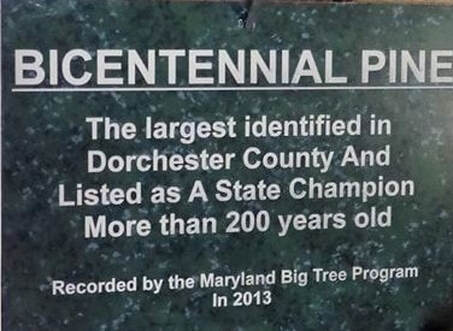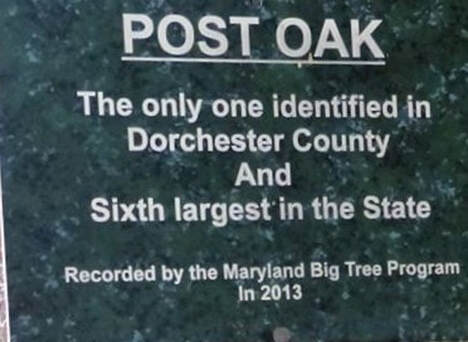Since colonial times timber has been an important resource on Taylors Island. The history has evolved from cutting trees for shipbuilding in the old days to cutting trees for fishing nets today. Also, our island has some historic and champion trees. Near the Brick Church is a Loblolly Pine that was listed as 220 years old in 1976 (making it 263 years old today). Next to the Grace Church is a champion Post Oak tree and next to the Chapel of Ease is a champion Persimmon tree. These historic locations and living trees are maintained by the Grace Foundation of Taylors Island.

Above image shows pound net posts that were harvested from a tree farm on the island and await pick up to be used to secure fishing nets in the bay (February 2019 - Bayshore Road)
The wooden stakes are pushed into the bottom of the Bay, spaced apart in a line that runs across the tide. Nets are strung between the stakes and along the bottom of the bay, making a fish trap. ... Each day the waterman goes out to the pound net and scoops the fish out with a hand net. The local Indians perfected this form of harvesting fish before colonial times.
Here is a short and slightly edited account of the timber industry in Dorchester County relating to Taylors Island as written by Carilton Nabb, which appeared in the Dorchester Banner on May 27, 2019:
In the early years of logging, a woods may have been cut over several times with the smaller trees given years to mature. Today clear cutting of all trees is usually the method used. At the turn of the century, county roads were really non-existent. Trails were made of dirt, oyster shells and wood slats. Timber could not be hauled on this type of road, so the creeks and rivers were the way the big trees traveled Brought out of the woods by mainly teams of oxen (such as in the photo below taken on Taylors Island in the 1920s), the single logs were pulled to the nearest waterway and floated with the tide to the creek or river used for the landing.
In the Taylors Island area, Claude Adams bought a large tract of timber and used the Stewarts Canal to float many logs out of the Smithville woods. The Adams family still owns waterfront property on Parsons Creek near Route 16. Mr. Adams went on to join up with two local business men and they together bought James Island.
Mr. Roscoe Willey from Cambridge and Mr. Byron Harrington from Taylors Island, along with Mr. Adams, purchased the then-200 acre island in the Chesapeake Bay. Much of the virgin pine was sold to the J.I. Wells Company for piling timber, and loads of logs were brought into Slaughter Creek on Earl Pritchett’s barges. Later the island was bought by Mr. Carlton Slagle from Cambridge. Dorchester Lumber harvested much of the remaining timber for utility poles that were also sold to J.T. Wells.
The boys at the Taylors Island store said that one night, Earl Pritchett set off a dynamite explosion that blew out half the windows on Taylors Island. I guess he needed a deeper landing area for his barge.
Click on each tree image below for more info on that particular tree:
Mr. Roscoe Willey from Cambridge and Mr. Byron Harrington from Taylors Island, along with Mr. Adams, purchased the then-200 acre island in the Chesapeake Bay. Much of the virgin pine was sold to the J.I. Wells Company for piling timber, and loads of logs were brought into Slaughter Creek on Earl Pritchett’s barges. Later the island was bought by Mr. Carlton Slagle from Cambridge. Dorchester Lumber harvested much of the remaining timber for utility poles that were also sold to J.T. Wells.
The boys at the Taylors Island store said that one night, Earl Pritchett set off a dynamite explosion that blew out half the windows on Taylors Island. I guess he needed a deeper landing area for his barge.
Click on each tree image below for more info on that particular tree:








